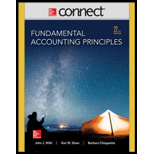
Concept explainers
Periodic Inventory system is an inventory system in which an organization updates the closing inventory balances in general ledger when it conducts physical inventory count. All purchases are recorded in purchase account and when physical counting is done then balance is transferred to inventory account.
There are several methods of calculating the value of inventory in closing stock which are as below:
FIFO method (First In First Out) is the most using method of
LIFO method (Last In First Out) is the method in which the quantity which purchase in last before sale transaction will be sold first. In closing inventory the quantity will be counted from the beginning inventory and purchase thereafter.
Weighted Average method is the most commonly used method after FIFO method. In weighted average the quantity of all purchases and beginning inventory is clubbed and then a weighted average rate is calculated and closing inventory is valued at weighted average rate.
Specific Identification method is the method in which the quantity is specifically identified that from which lot or purchases the closing stock is available and the closing inventory is valued by taking rates and quantities of that specific lot(s) from which closing inventory is available.
Under periodic method only at closing the inventory valuation is done and cost of goods is calculated as below:
Requirement-1
To Calculate:
In the given question we have to calculate the following details under periodic inventory system from the problem 6-3B:
- Cost of goods and quantity available for sale
Requirement-2
To calculate:
We have to calculate units in closing stock at month end.
Requirement-3:
To calculate:
We have to calculate cost of closing inventory using FIFO, LIFO, Weighted Average and Specific Identification method under periodic inventory system.
Requirement-4
To calculate:
We have to calculate gross profit under FIFO, LIFO, Weighted Average and Specific Identification method under periodic inventory system
Requirement-5:
To determine:
We have to determine that manager will prefer valuation method as it earns on percentage of gross profit.
Want to see the full answer?
Check out a sample textbook solution
Chapter 6 Solutions
FUND.ACCT.PRIN -ONLINE ONLY >I<
- If total debits exceed total credits on a trial balance, the difference is most likely:A. A net lossB. A recording errorC. A net incomeD. An overstatement of assetsarrow_forwardWhich of the following accounts would be found on the post-closing trial balance?A. Service RevenueB. Salaries ExpenseC. Retained EarningsD. Dividendsarrow_forwardNeed answer What type of account is Service Revenue?A. AssetB. LiabilityC. EquityD. Revenuearrow_forward
- No chatgpt What type of account is Service Revenue?A. AssetB. LiabilityC. EquityD. Revenuearrow_forwardWhat type of account is Service Revenue?A. AssetB. LiabilityC. EquityD. Revenueneed helparrow_forwardno ai What type of account is Service Revenue?A. AssetB. LiabilityC. EquityD. Revenuearrow_forward
- What type of account is Service Revenue?A. AssetB. LiabilityC. EquityD. Revenuearrow_forwardNo chatgpt Which of the following would be found in the investing activities section of the cash flow statement?A. Cash received from issuing sharesB. Cash paid for dividendsC. Cash paid for new equipmentD. Cash received from customersarrow_forwardWhich of the following would be found in the investing activities section of the cash flow statement?A. Cash received from issuing sharesB. Cash paid for dividendsC. Cash paid for new equipmentD. Cash received from customersno aiarrow_forward
- Which of the following would be found in the investing activities section of the cash flow statement?A. Cash received from issuing sharesB. Cash paid for dividendsC. Cash paid for new equipmentD. Cash received from customerhelo mearrow_forwardHelp Which of the following would be found in the investing activities section of the cash flow statement?A. Cash received from issuing sharesB. Cash paid for dividendsC. Cash paid for new equipmentD. Cash received from customersarrow_forwardWhich of the following would be found in the investing activities section of the cash flow statement?A. Cash received from issuing sharesB. Cash paid for dividendsC. Cash paid for new equipmentD. Cash received from customersarrow_forward

 AccountingAccountingISBN:9781337272094Author:WARREN, Carl S., Reeve, James M., Duchac, Jonathan E.Publisher:Cengage Learning,
AccountingAccountingISBN:9781337272094Author:WARREN, Carl S., Reeve, James M., Duchac, Jonathan E.Publisher:Cengage Learning, Accounting Information SystemsAccountingISBN:9781337619202Author:Hall, James A.Publisher:Cengage Learning,
Accounting Information SystemsAccountingISBN:9781337619202Author:Hall, James A.Publisher:Cengage Learning, Horngren's Cost Accounting: A Managerial Emphasis...AccountingISBN:9780134475585Author:Srikant M. Datar, Madhav V. RajanPublisher:PEARSON
Horngren's Cost Accounting: A Managerial Emphasis...AccountingISBN:9780134475585Author:Srikant M. Datar, Madhav V. RajanPublisher:PEARSON Intermediate AccountingAccountingISBN:9781259722660Author:J. David Spiceland, Mark W. Nelson, Wayne M ThomasPublisher:McGraw-Hill Education
Intermediate AccountingAccountingISBN:9781259722660Author:J. David Spiceland, Mark W. Nelson, Wayne M ThomasPublisher:McGraw-Hill Education Financial and Managerial AccountingAccountingISBN:9781259726705Author:John J Wild, Ken W. Shaw, Barbara Chiappetta Fundamental Accounting PrinciplesPublisher:McGraw-Hill Education
Financial and Managerial AccountingAccountingISBN:9781259726705Author:John J Wild, Ken W. Shaw, Barbara Chiappetta Fundamental Accounting PrinciplesPublisher:McGraw-Hill Education





